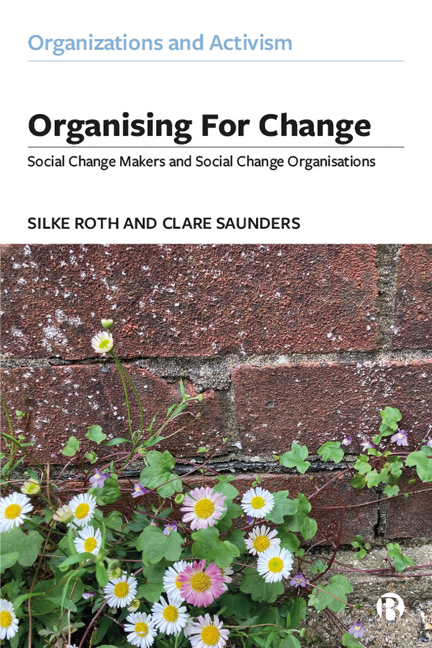Book contents
- Frontmatter
- Dedication
- Contents
- Series Editors’ Preface
- List of Figures and Tables
- Acknowledgements
- Introduction
- 1 What Are Social Change Makers and Social Change Organisations?
- 2 The Big Picture: Social Change Makers and Social Change Organisations in Historically Variable Contexts
- 3 Ways of Making Change
- 4 No Such Thing as a Free Gift: The Sources and Consequences of Resource Choices
- 5 People Making Change
- 6 Collaboration, Competition and Conflict
- 7 Outcomes of Social Change Making
- Conclusions: Organising for Change
- Appendix: Our Projects
- Notes
- References
- Index
3 - Ways of Making Change
Published online by Cambridge University Press: 28 March 2024
- Frontmatter
- Dedication
- Contents
- Series Editors’ Preface
- List of Figures and Tables
- Acknowledgements
- Introduction
- 1 What Are Social Change Makers and Social Change Organisations?
- 2 The Big Picture: Social Change Makers and Social Change Organisations in Historically Variable Contexts
- 3 Ways of Making Change
- 4 No Such Thing as a Free Gift: The Sources and Consequences of Resource Choices
- 5 People Making Change
- 6 Collaboration, Competition and Conflict
- 7 Outcomes of Social Change Making
- Conclusions: Organising for Change
- Appendix: Our Projects
- Notes
- References
- Index
Summary
In the late 1990s and early 2000s, the global justice movement (GJM) came to prominence around the world. It first grabbed the attention of journalists, academics and the public through large and oftentimes disruptive summit hopping demonstrations that coincided with meetings of the World Bank, the International Monetary Fund, the G20, G8, and G7. But a closer examination of the movement reveals, behind the scenes, multiple repertoires, strategies, and tactics tailored to specific grievances localities and settings. It is for this reason that Tarrow (2005) referred to the participants involved in these apparently global mobilisations as rooted cosmopolitans. While some of the SCMs associated with the GJM came together for big international demonstrations, they and many of their counterpart SCMs were rooted to locally situated concerns and shaped by more localised sets of geographically and historically variable contexts.
Some scholars consider the GJM as a ‘movement of movements’ (della Porta and Mosca, 2005; Cox and Nilsen, 2007) because it brought together a range of causes including environmentalism, humanitarianism, workers’ rights, and other struggles for equality. Together, the SCOs involved in the GJM used a range of strategies to seek justice for people and the environment across the globe. A useful way of thinking about the GJM is as a call for, in Paul Kingsnorth’s words, ‘one no, and many yeses’. This means that while the GJM universally rejects neo-liberal forms of capitalism that generate injustices (the ‘one no’), there were multiple ways to take action to begin to redress these injustices (the ‘many yeses’). These ranged from marches, occupations and riots through to hacking and reconnecting electricity supplies, reclaiming land, guerrilla gardening, and helping others in need.
The GJM provides a useful lens to examine the repertoires, strategies, and tactics of SCOs, and to illustrate how social change efforts are multi-faceted and shaped by geographically and historically variable contexts. It also shows the ways in which SCOs work together strategically (and sometimes less strategically) in chains of interacting strategic repertoires. This does not only apply to the GJM as we will show in this chapter.
- Type
- Chapter
- Information
- Organising for ChangeSocial Change Makers and Social Change Organisations, pp. 61 - 86Publisher: Bristol University PressPrint publication year: 2023



